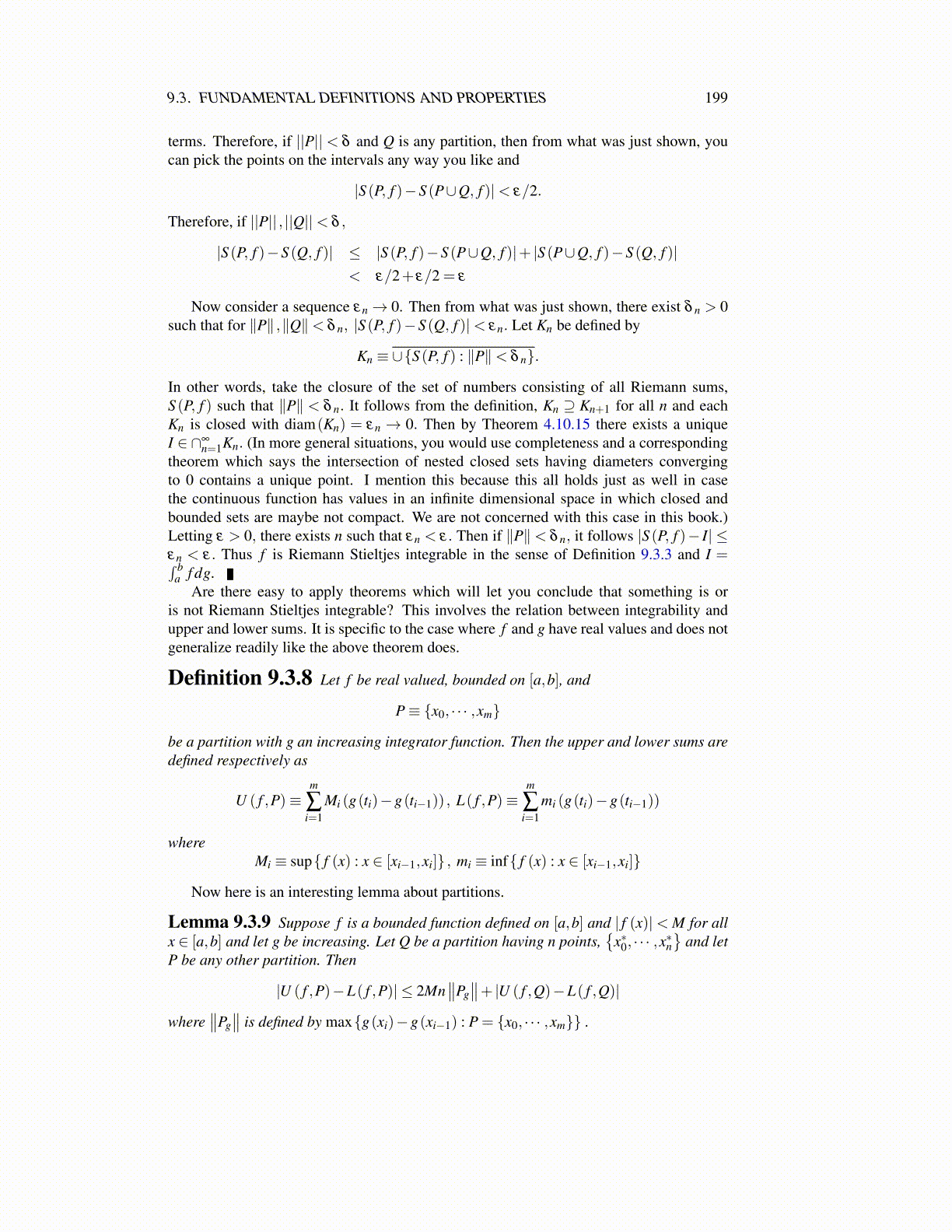
9.3. FUNDAMENTAL DEFINITIONS AND PROPERTIES 199
Then letting r (ε)≡ ε
6(g(b)−g(a)+1)n ,
U ( f ,P)−L( f ,P)<n
∑i=1
( f (tk)+ r (ε)− ( f (sk)− r (ε)))(g(xk)−g(xk−1))
<n
∑i=1
2r (ε)(g(xk)−g(xk−1))+
∣∣∣∣∣∑P f (tk)(g(xk)−g(xk−1))− I
∣∣∣∣∣+
∣∣∣∣∣∑P f (sk)(g(xk)−g(xk−1))− I
∣∣∣∣∣< ε
3+
ε
3+
ε
3= ε
Example 9.3.11 Let g(x) = x be increasing and continuous and let f be decreasing. Thenfor P = a = x0 < · · ·< xn = b a partition of equally spaced points,
U ( f ,P)−L( f ,P) =n
∑k=1
f (xk−1)(xk− xk−1)−n
∑k=1
f (xk)(xk− xk−1)
=b−a
n
n
∑k=1
( f (xk−1)− f (xk)) =b−a
n( f (a)− f (b))
Thus for n large enough, U ( f ,P)−L( f ,P) < ε . It follows∫ b
a f dx exists. A similar argu-ment shows that if f is increasing, then the integral exists.
From this important result, one can obtain fairly easily the fact that various functionsof Riemann integrable functions are Riemann integrable.
Definition 9.3.12 Let k : D×D→ R satisfy∣∣k (a,b)− k(â, b̂)∣∣≤ K
(|a− â|+
∣∣b− b̂∣∣) .
Such a function is called Lipschitz and K is called the Lipschitz constant.
Theorem 9.3.13 Let f ,h ∈ R([a,b] ,g) for g an increasing function and supposef ([a,b]) ,g([a,b]) are both contained in D. Let k : D×D→ R be Lipschitz with constantK. Then k ( f ,h) ∈ R([a,b] ,g).
Proof: By assumption and Theorem 9.3.13, along with the observation that if P ⊆ Q,then U ( f ,P)≥U ( f ,Q) and L( f ,P)≤ L( f ,Q) , there exists a partition P such that
U ( f ,P)−L( f ,P)< ε, U (h,P)−L(h,P)< ε.
Now let
Mki ≡ sup{k ( f (x) ,h(x)) : x ∈ [xi−1,xi]} ,
mki ≡ inf{k ( f (x) ,h(x)) : x ∈ [xi−1,xi]}
Mhi ≡ sup{h(x) : x ∈ [xi−1,xi]} ,mh
i ≡ inf{h(x) : x ∈ [xi−1,xi]} ,
a similar convention holding for M fi ,m
fi . Here P = {x0,x1, · · · ,xn}. Then
U (k ( f ,h))−L(k ( f ,h)) =n
∑k=1
(Mk
i −mki
)(g(xi)−g(xi−1))